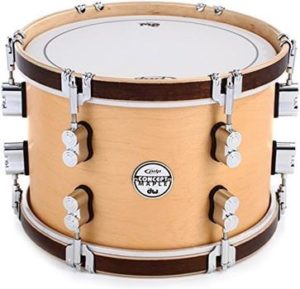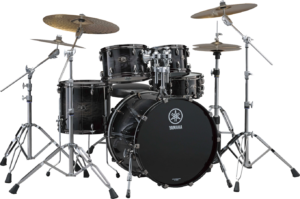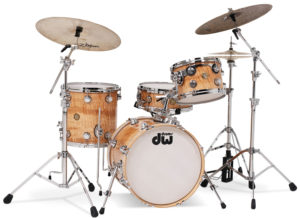
Note: The Drag is also sometimes called a Ruff.
In percussion music, a rudiment is one of a number of relatively small patterns which form the foundation for more extended and complex drum patterns. The term “rudiment” in this context means not only “basic”, but also fundamental. While any level of drumming may, in some sense, be broken down by analysis into a series of component rudiments, the term “drum rudiment” is most closely associated with various forms of field drumming, also known as rudimental drumming.
Rudimental drumming has something of a flexible definition, even within drumming societies devoted to that form of drumming. For example, the longest running website on rudimental drumming defines it as “the study of coordination,”[1] whereas the Percussive Arts Society defines rudimental drumming as a particular method for learning the drums—beginning with rudiments, and gradually building up speed and complexity through practicing those rudiments.[2] (An analogy might be made to learning the piano by first learning scales and arpeggios, as opposed to beginning by taking a full piece of music and grinding through it bit by bit, to the end.)
History
The origin of snare rudiments can be traced back to Swiss mercenaries armed with long polearms. The use of pikes in close formation required a great deal of coordination. The sound of the tabor was used to set the tempo and communicate commands with distinct drumming patterns. These drumming patterns became the basis of the snare drum rudiments.
The first written rudiment goes back to the year 1612 in Basel, Switzerland.[3] The cradle of rudimental drumming is said to be France, where professional drummers became part of the King’s honour guard in the 17th and 18th centuries. The craft was perfected during the reign of Napoleon I. Le Rigodon is one of the cornerstones of modern rudimental drumming.[3]
There have been many attempts to formalize a standard list of snare drum rudiments. The National Association of Rudimental Drummers, an organization established to promote rudimental drumming, put forward a list of 13 essential rudiments, and later a second set of 13 to form the original 26. In 1984, the Percussive Arts Society reorganized the first 26 and added another 14 to form the current 40 International Drum Rudiments.[4] Currently, the International Association of Traditional Drummers is working to once again promote the original 26 rudiments.
Today there are four main Rudimental Drumming cultures: Swiss Basler Trommeln, Scottish Pipe Drumming, American Ancient Drumming, and American Modern Drumming.
Terminology
single stroke
A stroke performs a single percussive note. There are four basic single strokes.
double stroke
A double stroke consists of two single strokes played by the same hand (either RR or LL).
diddle
A diddle is a double stroke played at the current prevailing speed of the piece. For example, if a sixteenth-note passage is being played then any diddles in that passage would consist of sixteenth notes.
paradiddle
A paradiddle consists of two single strokes followed by a double stroke, i.e., RLRR or LRLL.[5] When multiple paradiddles are played in succession, the first note always alternates between right and left. Therefore, a single paradiddle is often used to switch the “lead hand” in drumming music.
drag
A drag is a double stroke played at twice the speed of their context in which they are placed. For example, if a sixteenth-note passage is being played then any drags in that passage would consist of thirty-second notes. Drags can also be played as grace notes. When played as grace notes on timpani, the drag becomes three single (alternating) strokes (rlR or lrL).[6]
flam
A flam consists of two single strokes played by alternating hands (RL or LR). The first stroke is a quieter grace note followed by a louder primary stroke on the opposite hand. The two notes are played almost simultaneously, and are intended to sound like a single, broader note.[5] The temporal distance between the grace note and the primary note can vary depending on the style and context of the piece being played.
roll
Drum rolls are various techniques employed to produce a sustained, continuous sound.
Drumeo has a nice video showing the Drag Drum Rudiment Below
Drumeo writes: The drag ruff is a foundational rudiment that is required to play several more advanced patterns. It’s fairly basic on it’s own, but is still usable in a wide variety of drumming styles. The drag is perfect for ghost notes within drum beats, or as a lead in for simple drum fills.




Pingback: List of Snare Drum Rudiments - The Drum Rudiments.com